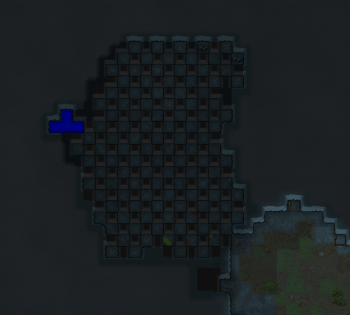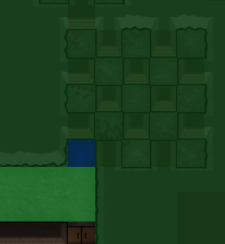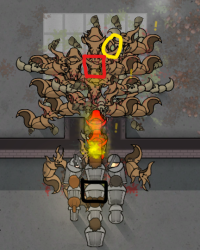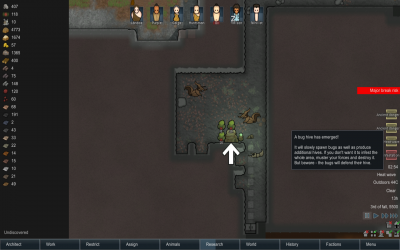Difference between revisions of "Infestation"
m (→Spawning) |
|||
| Line 4: | Line 4: | ||
Defeating an infestation grants a {{+|4}} ''Defeated insect hive'' [[mood]] buff to all pawns on the map. This buff lasts 10 days and stacks up to 5 times. | Defeating an infestation grants a {{+|4}} ''Defeated insect hive'' [[mood]] buff to all pawns on the map. This buff lasts 10 days and stacks up to 5 times. | ||
| − | == | + | == Natural Infestations == |
[[File:PSA INFESTATIONS.PNG|350px|thumb|right|Blue squares show an area with a chance of infestations spawning.]] | [[File:PSA INFESTATIONS.PNG|350px|thumb|right|Blue squares show an area with a chance of infestations spawning.]] | ||
[[File:PSA INFESTATIONS_2.PNG|225px|thumb|right|Making 1x1 squares will usually eliminate bugs.<br>But if a 1x2 area has a ''single'' mountain roof - regardless if the other tile is mountain or not - then it can spawn infestations.]] | [[File:PSA INFESTATIONS_2.PNG|225px|thumb|right|Making 1x1 squares will usually eliminate bugs.<br>But if a 1x2 area has a ''single'' mountain roof - regardless if the other tile is mountain or not - then it can spawn infestations.]] | ||
| Line 12: | Line 12: | ||
If generated from a quest, Infestations may spawn outside in the open. | If generated from a quest, Infestations may spawn outside in the open. | ||
| − | |||
| − | |||
| − | |||
| − | |||
| − | |||
===Preventing Spawn=== | ===Preventing Spawn=== | ||
| Line 23: | Line 18: | ||
As they require more than 1x1 of overhead mountain, you only need to build walls every second square. Only walls are capable of stopping infestations; columns and doors do not work. Note that an overhead mountain square next to an open "thin roof" area is also a valid spawn point. | As they require more than 1x1 of overhead mountain, you only need to build walls every second square. Only walls are capable of stopping infestations; columns and doors do not work. Note that an overhead mountain square next to an open "thin roof" area is also a valid spawn point. | ||
| − | == Behavior == | + | === Behavior === |
[[File:Insectoid hive aggro range.png|thumb|left|Range at which insects will defend a hive]] | [[File:Insectoid hive aggro range.png|thumb|left|Range at which insects will defend a hive]] | ||
| − | [[Insectoids]] ([[Megascarab]]s, [[Megaspider]]s and [[Spelopede]]s) will spawn near hives and spend their time roaming around them.They will attack and chase any intruder that comes within a 10-tile circular radius from the hive that spawned them, returning to their hives once the threat is gone. Insectoids will only attack creatures they can see, and will not attack while they are sleeping, provided they are not woken up. | + | [[Insectoids]] ([[Megascarab]]s, [[Megaspider]]s and [[Spelopede]]s) will spawn near hives and spend their time roaming around them. They will attack and chase any intruder that comes within a 10-tile circular radius from the hive that spawned them, returning to their hives once the threat is gone. Insectoids will only attack creatures they can see, and will not attack while they are sleeping, provided they are not woken up. |
They will randomly dig at stone and structures while wandering around their hives, potentially breaching into new areas. | They will randomly dig at stone and structures while wandering around their hives, potentially breaching into new areas. | ||
| Line 31: | Line 26: | ||
If any of the insectoids are downed or damaged, the entire infestation will go after colonists on the map, attacking and breaking down structures in the progress. Even if outside [[raider]]s or other factors (like hypothermic slowdown) down them, they will be aggressive. If insectoids don't see hostiles within 100 tiles, they will give up and return to their hives. | If any of the insectoids are downed or damaged, the entire infestation will go after colonists on the map, attacking and breaking down structures in the progress. Even if outside [[raider]]s or other factors (like hypothermic slowdown) down them, they will be aggressive. If insectoids don't see hostiles within 100 tiles, they will give up and return to their hives. | ||
| − | If the hives and insectoid colony are left intact, they will reproduce, progressively growing more numerous. But if all | + | If the hives and insectoid colony are left intact, they will reproduce, progressively growing more numerous. But if all megaspiders or spelopedes are killed, the hive(s) will deteriorate due to lack of maintenance. |
| + | |||
| + | ==Other infestations== | ||
| + | These events are called "infestations", but do not generate [[hive]]s, meaning they do not share the behavior as shown above. They are immediately hostile to colonists and will attack like [[raider]]s do. | ||
| + | |||
| + | ===Too Deep: Infestation=== | ||
| + | Insectoid infestations can spawn from digging from a [[deep drill]]. They don't seem to appear outside of active digging. Insectoids, but not hives, will pop out around the drill's area. These do not have the overhead mountain requirement like regular infestations. However, they are often smaller in number, and are unable to reproduce due to the lack of hive. | ||
| − | == | + | == Strategies == |
| − | {{ | + | {{See Also|Defense tactics#Infestations}} |
Infestations are most threatening in mountain bases, as they can spawn practically anywhere inside your base. In other bases, they are much less harmful - around a normal level threat. When fighting an infestation always ensure you ''completely annihilate every hive''. If even one is left, insectoids can keep spawning and leave you back where you started. | Infestations are most threatening in mountain bases, as they can spawn practically anywhere inside your base. In other bases, they are much less harmful - around a normal level threat. When fighting an infestation always ensure you ''completely annihilate every hive''. If even one is left, insectoids can keep spawning and leave you back where you started. | ||
| − | + | Since insectoids do not attack creatures while sleeping, it is possible to haul materials in and out of the area near their nests at night, including flammable material. This is however extremely risky, since attacking one of them, or doing construction near the insectoids, will wake them up. They also wake up when their individual need for rest has been filled, so be prepared (with all items staged in a nearby stockpile) and act quickly once they're asleep. | |
| + | |||
| + | ===Melee block=== | ||
| + | [[File:Grenades melee block.png|200px|thumb|right|[[Melee block]] with [[frag grenade]]s. Grenades not necessary.]] | ||
| + | With a few, well-armored melee colonists, insects can be very simple to deal with via a [[melee block]] tactic. | ||
| − | + | Use a chokepoint, such as in any [[door]]way. Have 3 melee colonists behind the chokepoint, and any amount of ranged fighters behind them. If done correctly (see right), you should have 3 colonists fight 1 insect at a time. As insects are only melee enemies, this is a trivial way to dispatch of insects. Frag grenades are extremely effective, but are not required. | |
| − | |||
| − | |||
| − | When | + | When designing a mountain base, you will want to create many chokepoints where you can melee block. You do not want to block colonists from standing behind the doorway, so place buildings away from the doorway. |
=== Mitigation === | === Mitigation === | ||
[[File:Planned infestation.jpg|300px|thumb|right|An infestation spawn point trapped with incendiary IEDs, surrounded by stone walls and doors.]] | [[File:Planned infestation.jpg|300px|thumb|right|An infestation spawn point trapped with incendiary IEDs, surrounded by stone walls and doors.]] | ||
| − | Insects are more likely to spawn in darkness, in "warm enough" temperatures, above -8°C (17.6°F). If you | + | Insects are more likely to spawn in darkness, in "warm enough" temperatures, above -8°C (17.6°F). |
| + | |||
| + | In a mountain base, you can create a "lure room". This will be a massive room that is warm, unlit, and dirty, ''very'' far away from your proper base. Since there will be many more valid tiles to spawn inside this room, infestations will most likely spawn there. You can then light this room on fire - see below for details. | ||
| + | |||
| + | If you are able to ensure that there is only one valid spawn location on your base map, you can prepare this area to automatically trap and kill the insects with fire when they appear. | ||
| − | + | ===Fire=== | |
| + | One way of dealing with infestations is with [[fire]]. This consists of 2 parts: | ||
| + | # Have a "lure" room - see above for details. In an outdoors base, it is likely that only 1-2 rooms have overhead mountain, meaning dedicated rooms can be built. | ||
| + | # Light it on fire. Fill it with flammable objects like [[barricade]]s and [[wood floor]]. You can either use [[molotov cocktail]]s or [[incendiary IED trap]]s to do the work. | ||
| + | Insects should die of [[heatstroke]] before they breach through 2-3 layers of door. | ||
| + | |||
| + | ===Insect AI=== | ||
| + | When attacked, insectoids will go after colonists without any walls between them first. This allows the insectoids to be lured away from their hives, chasing a runner colonist across the map. While they are away the hives can be destroyed. As long as hives are being damaged, the insectoids will keep chasing after colonists instead of returning to their hives. To keep the hive destroying pawns safe from having the insectoids' attention turned to them rather than the runner, a wall can first be built to block off the insectoids from the hives. Note that some new insectoids are likely to spawn at the hives during the process. Once all the hives are destroyed, the insectoids will wander the map like normal animals and soon starve to death. | ||
| − | |||
<br style="clear:both" /> | <br style="clear:both" /> | ||
| − | == | + | == Farming == |
[[File:Infestation.png|400px|thumb|left|The arrow points to the hive itself; to the right is a glowpod. Several stacks of jelly are also next to the hive, along with the usual suspects.]] | [[File:Infestation.png|400px|thumb|left|The arrow points to the hive itself; to the right is a glowpod. Several stacks of jelly are also next to the hive, along with the usual suspects.]] | ||
===Hives=== | ===Hives=== | ||
Revision as of 17:44, 13 March 2023
| This article is a stub. You can help RimWorld Wiki by expanding it. Reason: Wastepack infestations. |
Infestations are an event and a serious threat in which a number of hives are spawned, alongside insectoid defenders. They can happen randomly or can be caused by a quest; quests will warn you if this is an outcome. Infestations can also occur upon entering rooms in an ancient complex; you will get no specific warning for this quest.
Defeating an infestation grants a +4 Defeated insect hive mood buff to all pawns on the map. This buff lasts 10 days and stacks up to 5 times.
Natural Infestations
Natural infestations require an area larger than 1x1, where at least one tile has the overhead mountain roof, within 30 tiles of a colony structure. They are centered around a single "valid" tile, which must have a temperature higher than -17°C (1.4°F). Temperatures under -8°C (17.6°F) will gradually reduce the spawn chances, as does light.
Hives and insectoids will spawn within a given radius, regardless of whether those tiles are valid. A hive does not have to spawn on an infestation's center point. The initial size of an infestation is based on raid points, so infestations will get bigger as the game progresses. If the size of the event is larger than the "valid" space, it will happily expand to appear in nearby "invalid" areas, even if those areas are not directly connected.
If generated from a quest, Infestations may spawn outside in the open.
Preventing Spawn
When spawn proofing a base, be thorough - even a single warm tile can cause a full infestation. If there is any valid tile, infestations can spread nearby into seemingly safe areas, even if there is a wall many tiles thick between.
As they require more than 1x1 of overhead mountain, you only need to build walls every second square. Only walls are capable of stopping infestations; columns and doors do not work. Note that an overhead mountain square next to an open "thin roof" area is also a valid spawn point.
Behavior
Insectoids (Megascarabs, Megaspiders and Spelopedes) will spawn near hives and spend their time roaming around them. They will attack and chase any intruder that comes within a 10-tile circular radius from the hive that spawned them, returning to their hives once the threat is gone. Insectoids will only attack creatures they can see, and will not attack while they are sleeping, provided they are not woken up.
They will randomly dig at stone and structures while wandering around their hives, potentially breaching into new areas.
If any of the insectoids are downed or damaged, the entire infestation will go after colonists on the map, attacking and breaking down structures in the progress. Even if outside raiders or other factors (like hypothermic slowdown) down them, they will be aggressive. If insectoids don't see hostiles within 100 tiles, they will give up and return to their hives.
If the hives and insectoid colony are left intact, they will reproduce, progressively growing more numerous. But if all megaspiders or spelopedes are killed, the hive(s) will deteriorate due to lack of maintenance.
Other infestations
These events are called "infestations", but do not generate hives, meaning they do not share the behavior as shown above. They are immediately hostile to colonists and will attack like raiders do.
Too Deep: Infestation
Insectoid infestations can spawn from digging from a deep drill. They don't seem to appear outside of active digging. Insectoids, but not hives, will pop out around the drill's area. These do not have the overhead mountain requirement like regular infestations. However, they are often smaller in number, and are unable to reproduce due to the lack of hive.
Strategies
Infestations are most threatening in mountain bases, as they can spawn practically anywhere inside your base. In other bases, they are much less harmful - around a normal level threat. When fighting an infestation always ensure you completely annihilate every hive. If even one is left, insectoids can keep spawning and leave you back where you started.
Since insectoids do not attack creatures while sleeping, it is possible to haul materials in and out of the area near their nests at night, including flammable material. This is however extremely risky, since attacking one of them, or doing construction near the insectoids, will wake them up. They also wake up when their individual need for rest has been filled, so be prepared (with all items staged in a nearby stockpile) and act quickly once they're asleep.
Melee block
With a few, well-armored melee colonists, insects can be very simple to deal with via a melee block tactic.
Use a chokepoint, such as in any doorway. Have 3 melee colonists behind the chokepoint, and any amount of ranged fighters behind them. If done correctly (see right), you should have 3 colonists fight 1 insect at a time. As insects are only melee enemies, this is a trivial way to dispatch of insects. Frag grenades are extremely effective, but are not required.
When designing a mountain base, you will want to create many chokepoints where you can melee block. You do not want to block colonists from standing behind the doorway, so place buildings away from the doorway.
Mitigation
Insects are more likely to spawn in darkness, in "warm enough" temperatures, above -8°C (17.6°F).
In a mountain base, you can create a "lure room". This will be a massive room that is warm, unlit, and dirty, very far away from your proper base. Since there will be many more valid tiles to spawn inside this room, infestations will most likely spawn there. You can then light this room on fire - see below for details.
If you are able to ensure that there is only one valid spawn location on your base map, you can prepare this area to automatically trap and kill the insects with fire when they appear.
Fire
One way of dealing with infestations is with fire. This consists of 2 parts:
- Have a "lure" room - see above for details. In an outdoors base, it is likely that only 1-2 rooms have overhead mountain, meaning dedicated rooms can be built.
- Light it on fire. Fill it with flammable objects like barricades and wood floor. You can either use molotov cocktails or incendiary IED traps to do the work.
Insects should die of heatstroke before they breach through 2-3 layers of door.
Insect AI
When attacked, insectoids will go after colonists without any walls between them first. This allows the insectoids to be lured away from their hives, chasing a runner colonist across the map. While they are away the hives can be destroyed. As long as hives are being damaged, the insectoids will keep chasing after colonists instead of returning to their hives. To keep the hive destroying pawns safe from having the insectoids' attention turned to them rather than the runner, a wall can first be built to block off the insectoids from the hives. Note that some new insectoids are likely to spawn at the hives during the process. Once all the hives are destroyed, the insectoids will wander the map like normal animals and soon starve to death.
Farming
Hives
Hives spawn insect jelly in stacks of 20 units every day or so. You can farm these by building walls and doors, but insects may dig out and attack your colony. You can retrieve the jelly when the insects are asleep.
Hives also spawn glow pods, which provide light for 20 days. These can be re-installed in your base once insectoids are destroyed.
Meat
Insects will give insect meat when butchered. While colonists usually dislike eating insects, it is only a -3 moodlet when cooked - a carnivore fine meal is a net +2 mood from simple meals. Insect meat can also be converted into chemfuel from a biofuel refinery, or sold as meals with no penalty.
If the "Insect Meat: Loved"![]() precept is used, colonies can be fed exclusively on insect meat and be ecstatic about it.
precept is used, colonies can be fed exclusively on insect meat and be ecstatic about it.
Taming
If you destroy all hives of an infestation, then any insects that are downed will become neutral. Megaspiders are an advanced trainability animal that can be tamed without a manhunter chance.





